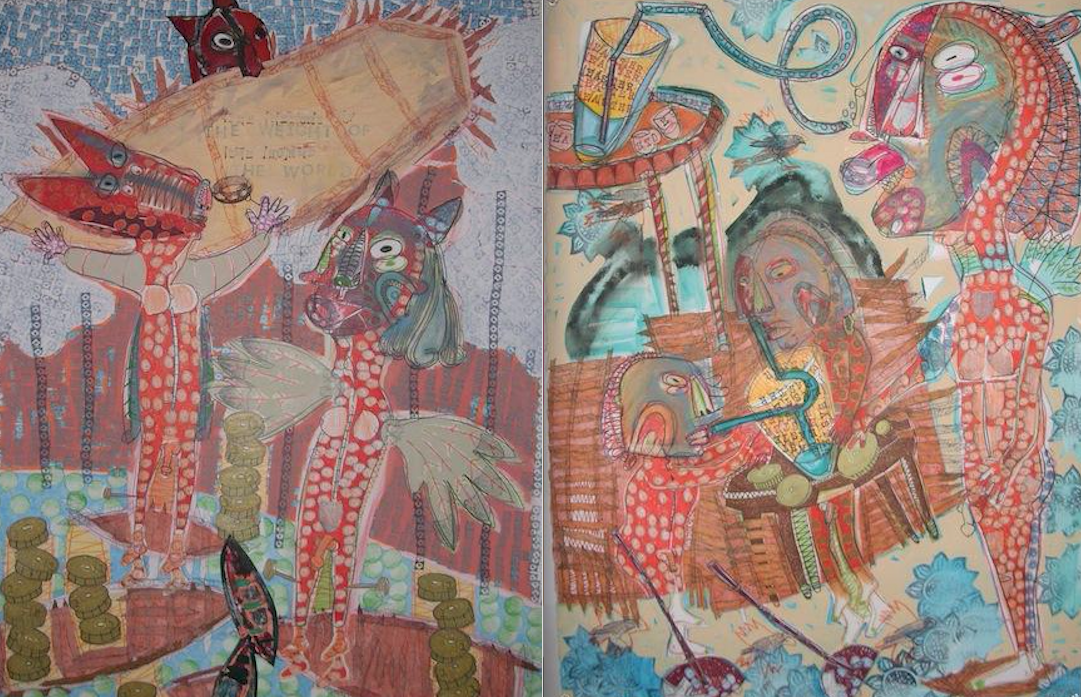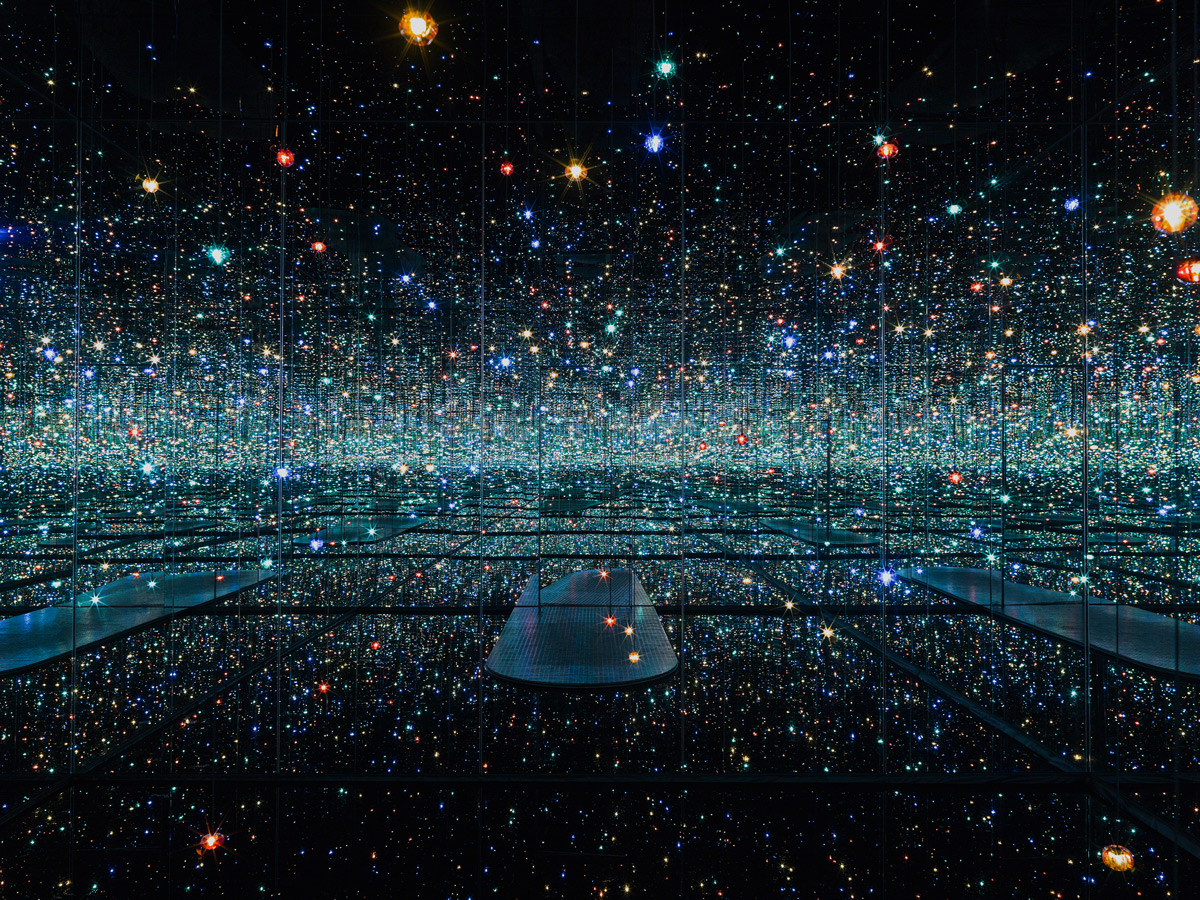Yayoi Kusama: Infinity Mirrors at the Hirshhorn Museum
I am standing in a small mirrored room staring into infinity through a sea of blinking lights and my own myriad reflections, lost in a silent reverie that ends too suddenly with a quiet knock on the door.
For better or worse, Yayoi Kusama: Infinity Mirrors at the Hirshhorn Museum is pure unadulterated Instagram bait, offering six of her immersive Infinity Mirror Rooms together for the first time along with other sculptures, paintings, and work on paper spanning her 65-year career. Known for polka dots and pumpkins, Kusama’s life has ping-ponged across continents and in and out of the public eye.

Now 87 years old, she gained fame in influential New York art circles in the 1960s with art “happenings” and Vietnam War protests before slipping into obscurity after returning home to Japan in 1973. Suicidal thoughts and a mental breakdown led to her voluntarily living in a psychiatric hospital in Tokyo where she still resides more than 40 years later, but her battle with mental illness is glossed over in the exhibition. Her career has surged back in recent years, and this exhibition is the first in the Hirshhorn’s history where free timed passes are being distributed, which crashed the museum’s website from the intense demand.
Kusama has spoken of hallucinations and obsessions dating back to an unhappy childhood under the reign of a philandering father and unforgiving mother. Some of her early paintings featured repetitive strokes of paint that evolved into polka dots in an effort to quiet her mind and obliterate the self, a common theme in her work. Kusama has said polka dots are a symbol of peace and the infinite cosmos.
The Infinity Mirror Rooms began in the 1960s when Kusama was struggling financially in New York but also was exhibiting her work with Andy Warhol, Claes Oldenburg and other pop art luminaries. She had an intense fear of sex from her strict upbringing that she rebelled against by staging “happenings” and nude body festivals at Washington Square Park, Wall Street, and other locales that sometimes morphed into protests against the Vietnam War. In an open letter to “my hero Richard Nixon,” she implored him to stop the Vietnam War and said, “Let’s forget ourselves, dearest Richard, and become one with the Absolute, all together in the altogether.”

In Infinity Mirror Room-Phalli’s Field, the first in the Hirshhorn exhibition, the floor is covered with hundreds of sewn and stuffed white phallus shapes adorned with red polka dots, rising in a field of protuberances that extend infinitely in every direction while the viewer towers above them in refracted multiple reflections. The hallucinatory effect renders the stuffed phalluses small and humorous as they diminish into the imagined distance where they lose their distinct form, merging together like a field of poppies.
One of the most captivating rooms is The Souls of Millions of Light Years Away (pictured at top), which also is the darkest so your own reflections fade into a vast expanse of hundreds of hanging LED lights that shift in time and rhythm like an endless universe. While it may sound disorienting, the experience instills a true sense of wonder.
I felt immersed in that imaginary world and forgot for a moment that I was in a museum or even looking at art. But then there was that distracting knock on the door. Because of the anticipated crowds, visitors will only get 20 or 30 seconds in each room before they are ushered out. While I got longer stretches during the press preview, the immediate instinct for most people, including myself, will be to scramble for your phone and fire off as many pictures as possible during that one commercial break. Then you’ll have to go back to your phone after posting the pics on Instagram and Facebook to remember what you really saw in the first place, and the pictures won’t do it justice. The moment will be gone, vanished into the ether, so rest that itchy trigger finger for at least a few seconds to experience the present moment.


In Aftermath of Obliteration of Eternity, miniature flickering lights resembling golden lanterns fill the darkened expanse with their floating luminescent forms, creating a galaxy of stars reminiscent of toro nagashi, a Japanese tradition where candlelit paper lanterns float down a river in a sign of respect for ancestors and to guide them home.
Other mirror rooms feature an endless field of lighted pumpkins (Linus would love it), a bright flashing grid of LED lights, or inflated pink polka-dotted balls that are fun but veer toward pure whimsy without much substance supporting them. But what’s wrong with whimsy? Is it too light and frothy for “serious” art critics? In a frenetic world fueled by hate and anger, we need all the whimsy we can get.

In the final Obliteration Room, visitors can stick colored dots all over a room representing the interior of a house with a piano, dining room table, and book shelves. There’s something both satisfying and transgressive about touching objects in an art museum and plastering stickers onto them, but the effect will be more interesting later in the exhibition’s run when the accumulation of dots truly overwhelm the pristine white backdrop in a dizzying array of color.
While there is a feast for the senses, visitors won’t get a true sense of Kusama’s life because the exhibition ignores her battles with mental illness. The wall text fails to mention that she has lived in a psychiatric hospital for four decades, a fact which would seem hard to miss. She wrote a poem about suicide and swallowing antidepressants, and much of her work has been a reaction or balm for her inner turmoil, an attempt to transcend the horrors of the present moment and step into the divine. But the exhibition, organized by Hirshhorn associate curator Mika Yoshitake, ignores most of the professional and personal challenges that Kusama faced and presents a steady march of artwork through the decades that is divorced from personal history or context. Kusama’s identity as a human being gets lost behind the polka dots.

There also is a danger in letting an artist’s life story subsume the art, but there’s a common misperception that mental illness somehow produces transcendent work from the ether, as if the artist’s skill and dedication had nothing to do with it. Mental illness may inform the work but it doesn’t define it.
As a mixed-media artist, I’ve had my own struggles with mental illness, and it usually hasn’t helped my creative output. It’s called a struggle for a reason, but ignoring the effects of mental illness or its relationship to Kusama’s artwork keeps mental illness locked in the shadows where shame and suffering fight for control.
Kusama doesn’t travel anymore for health reasons so she won’t see her own traveling exhibition at the Hirshhorn or the five remaining stops at museums in Seattle, Los Angeles, Toronto, Cleveland and Atlanta. Wearing her trademark bright-red wig and a polka-dotted dress, Kusama speaks in Japanese in a video welcoming visitors to the exhibition, explaining the immersive nature of her work and her hopes for all of us.
“This effect of continual repetition calls out to the human senses, and in return, deep inside of our hearts, we yearn for true amazement,” she said. “Far beyond the reaches of the universe, infinity is trying to communicate with us.”

***********
Brendan L. Smith is a freelance journalist and mixed-media artist in Washington, D.C.
Yayoi Kusama: Infinity Mirrors will be on view at the Hirshhorn Museum until May 14.






